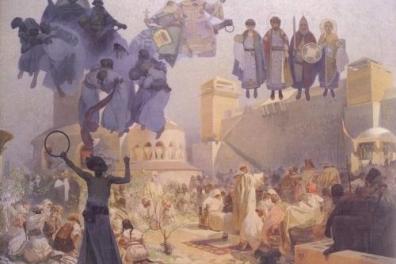Middle Europe in the Great War: between events and traces

For the past three years, the CREE (Centre de recherche Europe Eurasie) has been developing, with several French and European partners, a vast research project at the heart of the revitalization of studies on the Great War in a now transnational perspective, a landmark element in the evolution of the study of this field over the past ten years. This project addresses the heart of the continent, from the Baltic to the Adriatic, drawing on the cross-cutting approach to history that combines micro- and macro-historical scales. It has been applied in this project to several categories of objects: the Austro-Italian front and the rear in war-torn Austria-Hungary.
The Austro-Italian front (1915-1918). International research group
This project is based on the perpetuation of the work of an international research group initiated by CREE in 2016, which set out to work specifically on the Austro-Italian front. Since its creation, this research group has organized three colloquia in Padua, Paris and Ljubljana. They have helped to open up and consolidate an international network working on this subject, and these colloquia have become the sole forum for exchanges on the progress of international research on this subject.
The scientific responsibility for the colloquia is assumed jointly by its historical partners - the CREE, the UMR SIRICE, the Institut historique italo-germanique (ISIG-FBK), the University of Ljubljana - who make up the permanent scientific committee and an ad hoc national committee set up by the inviting institution. The next symposium will take place in September 2019 in Bratislava. In the coming years (2019-2023), this research group will be a key component of CREE's "Medieval Europe: from events to traces" project. The proceedings of the first colloquia will shortly be published in the "Quaderni" collection of the journal Ricerche storici (2018) and by Peter Lang (late 2018-early 2019).
The tools for analyzing Austria-Hungary at war
These are addressed from several angles: through a research program on writing in war that led to publication in the Revue des études slaves (tome 88, 2017, fasc. 4) and another ongoing project on the recompositions of solidarities during the war. Research workshops prepared jointly with UMR SIRICE and LabEx EHNE also enabled reflection on new analytical tools and new approaches to studies on the Great War, bringing together colleagues from the universities of Vienna, Ljubljana, Hradec Kralové, Oxford (Queen's College), the Normal School of Pisa and the Jagiellonian University of Krakow. The colloquium co-organized with UMR SIRICE from June 14 to 16, devoted to local approaches to the recompositions of Habsburg Europe during the autumn of 1918-spring of 1919, is conceived as a milestone that provides a projection towards the continuation of this research program.
Ongoing programs
While pursuing these projects, we are now broadening our focus by preparing a collective work resulting from a working group set up in 2017. Its aim is to articulate a thematic analysis of the historiography of Austria-Hungary in the Great War from a deliberately transnational perspective, enabling us to move beyond the fragmented or simply bilateral analyses that have dominated until now. This work requires a large team currently built around colleagues from Maynooth University, the Jagiellonian University in Krakow, the University of Ljubljana, the Masaryk Institute of the Czech Academy of Sciences, the Institute of History of the Slovak Academy of Sciences, and the Ludwig Boltzmann-Institut in Vienna. The project is scheduled for completion in 2021.
Scientific contact:
View e-mail, lecturer at Inalco, HDR, Laboratoire CREE